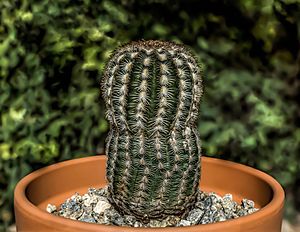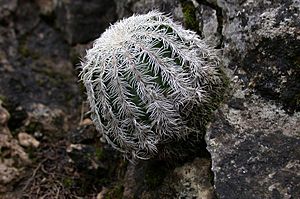Echinocereus reichenbachii facts for kids
Quick facts for kids Echinocereus reichenbachii |
|
|---|---|
 |
|
| var. reichenbachii | |
| Conservation status | |
| Scientific classification |
The Echinocereus reichenbachii is a type of cactus often called the lace or hedgehog cactus. It's a perennial plant, meaning it lives for more than two years. This cactus grows as a shrub and is part of the cactus family.
You can find this plant naturally in the Chihuahuan Desert and parts of northern Mexico and the southern United States. It grows in places up to 1,500 meters (4,900 ft) high. This special cactus has even won an award called the Royal Horticultural Society's Award of Garden Merit for being a great garden plant!
E. reichenbachii is one of the smaller types of Echinocereus cacti. It usually grows to be about 7.5 to 30 centimetres (3.0 to 11.8 in) tall and 4 to 10 centimetres (1.6 to 3.9 in) wide. These plants can grow alone or in groups of up to 12. Their stems stand straight up and have 10 to 19 ribs.
The stems are dark green, but you might not see them easily because of the many spines. These spines can be tan, brown, black, or pink, and their tips are usually darker. Each small area on the cactus, called an areole, has between seven and 36 spines.
Beautiful purple or pink flowers bloom on these cacti from early May to late June. The flowers are quite large, about 4.5 to 8 centimetres (1.8 to 3.1 in) long and 5 to 10 centimetres (2.0 to 3.9 in) wide. E. reichenbachii cacti are tough! They can handle both cold and heat. They like dry, well-drained soil, especially near rocky areas.
Contents
What's in a Name?
The scientific name, Echinocereus, comes from two old words. Ekhinos is a Greek word meaning hedgehog, and cereus is a Latin word for wax paper. So, it's like a "hedgehog wax paper" plant! The second part of its name, reichenbachii, honors a German botanist named Ludwig Reichenbach.
People have many common names for this cactus, like Lace hedgehog cactus, Lace cactus, Lace hedgehog, Purple candle, and Órgano-pequeño de colores.
Different Kinds of Lace Cactus
There are several different types, or "variations," of Echinocereus reichenbachii. Some of these include E. reichenbachii var. albertii, E. reichenbachii var. fitchii, and E. reichenbachii var. albispinus.
One important variation is E. reichenbachii var. albertii, also known as the Black Lace cactus. This type is a federally endangered species in the United States. This means it's at risk of disappearing forever. It only grows naturally in Texas. Since 1979, it has been listed as endangered. This is mainly because its natural home is being destroyed, too many people are collecting it, and livestock are eating it.
How it Looks
The Echinocereus reichenbachii is a perennial plant and a shrub. It's one of the smaller Echinocereus types. When they are young, these cacti are round like a ball. As they grow, they become more like a cylinder.
They can grow alone or in groups of up to twelve plants. Their stems stand straight up and have 10 to 19 slightly wavy ribs. They reach 7.5 to 30 centimetres (3.0 to 11.8 in) tall and 4 to 10 centimetres (1.6 to 3.9 in) wide. The stems are dark green, but they are often hidden by the many spines. This is especially true when the plant is dry.
The small areas where spines grow, called Areoles, are oval or elliptical. They are spaced 1 to 6 millimetres (0.039 to 0.236 in) apart. Each areole can have 15 to 36 spines. These spines can be tan, brown, black, purplish black, or pink. The tips of the spines are usually darker than the rest of the spine. The central spines are often the darkest. There can be up to 7 central spines per areole, and they are 1 to 6 millimetres (0.039 to 0.236 in) long.
These plants flower in early May and late June. They produce fruit about 6 to 10 weeks after the flowers bloom. Each flower only opens for one day. However, the flowers usually open at different times, so the plant can have blooming flowers for a whole week. The flower buds are covered in white fuzz. This fuzz hides the fruit as it grows.
The inner parts of the flower petals are silvery pink or magenta. The outer parts can be white, crimson, green, or many colors. The flowers are about 4.5 to 8 centimetres (1.8 to 3.1 in) long and 5 to 10 centimetres (2.0 to 3.9 in) wide. The flower tubes are 22 to 40 millimetres (0.87 to 1.57 in) long and 10 to 30 millimetres (0.39 to 1.18 in) wide. The tubes have hairs that are 5 to 15 millimetres (0.20 to 0.59 in) long. The part of the flower that holds nectar is 2 to 5 millimetres (0.079 to 0.197 in) deep. Each flower has 30 to 50 petals, which can look ragged or notched. The pistils are green and have many lobes. The stamens, which produce pollen, are cream-colored or yellow. The fruits are different shades of green and are 15 to 28 millimetres (0.59 to 1.10 in) long.
Where it Lives
The E. reichenbachii cactus naturally lives in the entire Chihuahuan Desert and the grasslands nearby. It also grows in woodlands with oak and juniper trees. These cacti grow at elevations up to 1,500 meters (4,900 ft).
In the United States, you can find E. reichenbachii in Texas, New Mexico, Colorado, and Nebraska. They also grow in Kansas and Oklahoma. The type found in Oklahoma, called E. reichenbachii baileyi, has very long, "bristle-like" spines. In northern Mexico, E. reichenbachii is native to the states of Coahuila, Nuevo León, and Tamaulipas.
Growing and Caring for It
E. reichenbachii cacti love full sun and don't need much water. They grow best in dry, well-drained soils that are gravelly, clay, or loam. They also like to grow near rocky areas.
These cacti can handle both cold and heat. They grow well even when kept indoors under glass. They can survive dry periods, but they can sometimes get mealybugs and scale insects.
You can grow new plants from seeds. The seeds are collected when the fruits start to dry out. This cactus is often used in gardens and parks as a decorative plant, especially in desert areas. Deer usually don't like to eat these plants. As mentioned before, E. reichenbachii has won the Royal Horticultural Society's Award of Garden Merit.
Images for kids
See also
 In Spanish: Echinocereus reichenbachii para niños
In Spanish: Echinocereus reichenbachii para niños






